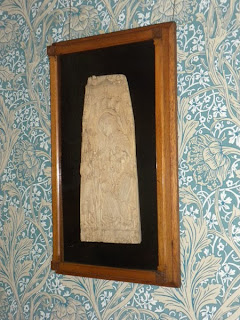One of a small number of objects on permanent
display in the museum depicting scenes from the Christmas story is a plaster
cast plaque showing the three wise men presenting gifts to the Christ child, set
within a shadowbox created by Isaac Scott.
The piece is one of four fictile ivories hung over the mantel in the
courtyard bedroom. In this article, we
will examine the story behind the original artwork as well as how the copy was
made.
The original piece, entitled “The Adoration of
the Magi,” was acquired by the Victoria and Albert Museum (V&A) in London in
1866 and is currently on display in their Medieval and Renaissance
Gallery. Carved by an unknown artist from
the bone of a Rorqual, or Finner whale, it was created between 1120 and 1150
A.D. in northern Spain and measures 14.4” tall by 6.3” wide.
Courtesy of the V&A
The website for the V&A states the following
about the original:
“The relief is one of the strangest surviving
representations of the Adoration of the Magi and the largest surviving medieval
carving in bone. The artist’s love of decoration
can be seen in the elaborately pleated drapery edged with geometric designs;
even the area around the Virgin’s feet is filled by foliate scrolls and a small
tree.”
It was originally thought that the relief was of
English origin but subsequent research has linked it stylistically with other
work executed in Northern Spain. The
level of craftsmanship is very high, and the depiction of the kings as pilgrims
was very popular along the road to Santiago de Compostela. Additional symbolism includes beasts fighting
at the feet of the Virgin Mary, and an owl above, which some scholars have
interpreted as reflecting the circumstances of “reconquista” in which the
object was produced.
Courtesy of the V&A
The largest figure is the Virgin Mary, seated
beneath a Romanesque arch from which is hung an elaborately detailed
drapery. She wears a pleated head dress
and a jeweled diadem. The Christ child
is seated on her left knee, with the three kings at far left, crowned and
carrying staves, offering their traditional gifts of gold, frankincense, and myrrh.
Courtesy of the V&A
The maker of the cast owned by the Glessners is
unknown, but information from the Powerhouse Museum in Sydney Australia
provides a possible source. That museum
owns a large collection of fictile ivories (the term for copies made from
original ivory or bone carvings) made in England during the period in which
John and Frances Glessner purchased their pieces.
Two Englishmen, J. O. Westwood and A. Nesbitt,
made numerous casts of original artworks, which are described in a catalogue
entitled “A Descriptive Catalogue of the Fictile Ivories in the South
Kensington Museum” published in 1876. (The
South Kensington Museum was the original name for what is now the V&A.) The process involved mixing wax and gutta-percha
(a natural latex derived from a variety of trees in Malaysia) which was then
flattened into a piece larger than the artwork to be copied. The artwork was wetted with cold water or
soap, after which the mix of wax and gutta-percha was placed upon it and
pressed carefully so as to reach into all the deeper cut parts of the
work. After the mixture hardened and
cooled, it was lifted carefully from the artwork, after which it was ready to
receive plaster of Paris.
The molds were used by Westwood and Nesbitt to
create numerous copies, and other makers were allowed to use the molds to make
their own copies as well. Plaster casts
in general became very popular in the mid- to late-19th
century. They were widely purchased for
domestic use, but many museums also acquired large collections, such as the
Powerhouse Museum in Sydney which acquired 650 casts during the mid-1880s.
During the 1870s and 1880s, the Chicago Tribune featured several
articles that discuss plaster casts as art, and how the pieces were made. An article in 1878 mentions that the managers
of the Interstate Industrial Exposition (which the Glessners attended each
year) were assembling a large collection of plaster casts. One prominent Chicago dealer was Anthony Equi,
so it is highly probably the Glessners either acquired their casts directly at
the Exposition or through Equi’s gallery.
Frame detail
The four casts purchased by the Glessners were
set into custom-made shadowboxes designed and executed by Isaac Elwood Scott,
who created numerous other picture frames and pieces of furniture for the
Glessner family. The framed pieces show
up in photos of the Glessners’ previous home on Washington Street, so were
definitely acquired by them prior to their move to Prairie Avenue in 1887.
Today, the striking “Adoration of the Magi” and
the other fictiles continue to impress visitors with their fine detailing, warm
patina, and handsome shadow boxes.






No comments:
Post a Comment